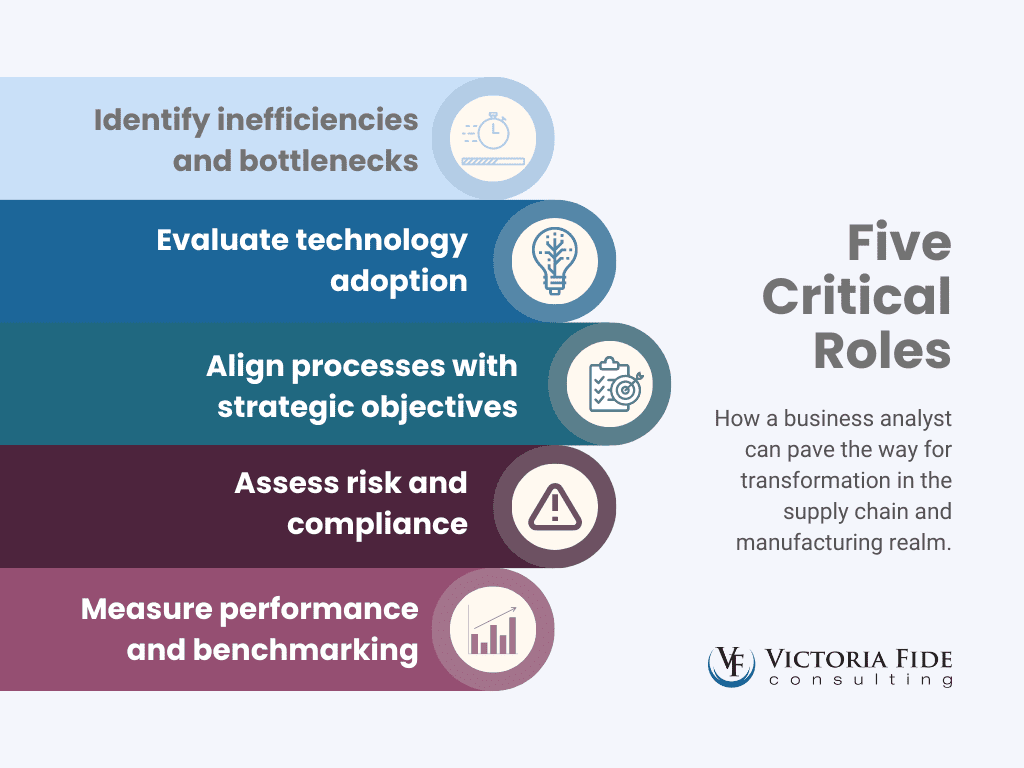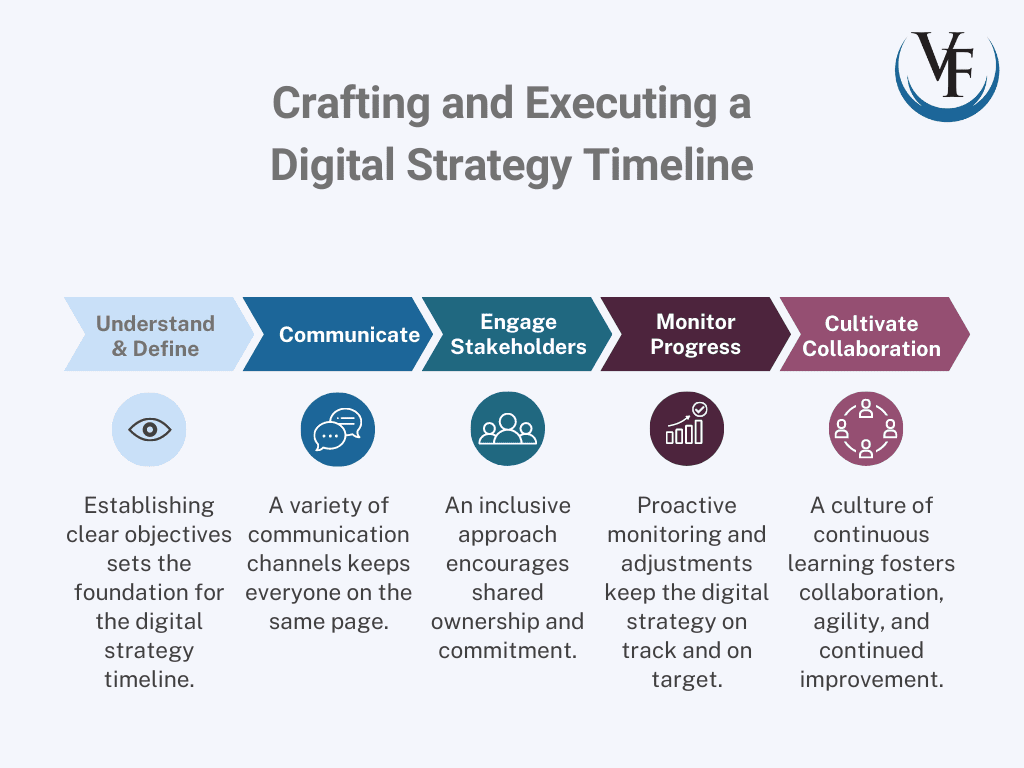
Table of Contents
Digital transformation is quickly becoming a priority for companies looking to stay competitive in today’s digitally driven business world. A key component of any successful transformation is expertise in the areas that need transforming — and that’s where supply chain and manufacturing business analysts come into play. Business analysts are essential for uncovering opportunities, overcoming challenges, structures systems and processes, achieving performance benchmarks and helping organizations reach their desired outcomes more efficiently. This blog post explores the critical role of business analysts and why they are such an integral part of digital transformation for supply chain and manufacturing.
What is a business analyst?
Business analysts play a critical role in identifying the need for organizational change within the supply chain and manufacturing realm. By leveraging their expertise in data analysis, process improvement, and strategic planning, they can pinpoint areas of inefficiency and pave the way for transformation. Here are five key ways business analysts can clarify the need for organizational change in supply chain and manufacturing.
5 Essential Roles of Business Analysts in Change Management:
1. Identify inefficiencies and bottlenecks
Business analysts can analyze the current state of supply chain and manufacturing operations, looking for inefficiency, bottlenecks, or waste patterns. By systematically identifying these issues, analysts can present a clear case for change and offer insights into areas that require immediate attention. This data-driven approach helps organizations understand the necessity for change and prioritize their efforts.
2. Evaluate technology adoption
Technology is essential for supply chain and manufacturing success in today’s competitive environment. Business analysts can assess the organization’s current technology landscape, identifying gaps and opportunities for improvement. By benchmarking against industry best practices and evaluating new technology implementations’ potential return on investment (ROI), analysts can help organizations make informed decisions on adopting innovative solutions that streamline operations and drive growth.
3. Align processes with strategic objectives
Organizational change is often required when the existing supply chain and manufacturing processes need to be aligned with the company’s strategic objectives. Business analysts can bridge this gap by working closely with decision-makers to understand the organization’s goals and priorities. By mapping current processes and operations to these objectives, analysts can highlight areas where change is necessary to achieve the desired outcomes, enabling organizations to make targeted improvements that align with their strategic vision.
4. Assess risk and compliance
Supply chain and manufacturing processes are subject to various risks, including geopolitical, environmental, and regulatory factors. Business analysts can evaluate the organization’s risk exposure and compliance status, identifying potential threats and areas where regulatory requirements still need to be met. By clearly understanding these risks and compliance gaps, business analysts can help organizations proactively address them through organizational change, minimizing potential negative impacts and ensuring ongoing business continuity.
5. Measure performance and benchmarking
Performance measurement is essential to understanding the effectiveness of supply chain and manufacturing processes. Business analysts can establish key performance indicators (KPIs) and benchmark the organization’s performance against industry standards or competitors. This analysis enables organizations to identify areas where they are underperforming, providing a solid rationale for change. In addition, by tracking the impact of implemented changes over time, business analysts can also demonstrate the value of these initiatives and guide further adjustments as needed.

A business analyst is crucial in clarifying the need for organizational change in the supply chain and manufacturing. Analysts provide valuable insights that drive informed decision-making by identifying inefficiencies, evaluating technology adoption, aligning with strategic objectives, assessing risk and compliance, and measuring performance. By leveraging their expertise, organizations can successfully implement change, improve efficiency, and achieve their strategic goals in a rapidly evolving business landscape.
Crafting and Executing a Digital Timeline
Business analysts are essential in guiding the successful execution of a digital strategy in supply chain and manufacturing organizations. One of their primary responsibilities is ensuring all stakeholders are informed, aligned, and working towards the same objectives. To achieve this, business analysts use various techniques for creating and managing a digital strategy timeline that helps keep everyone on the same page.
Understand and Define Business Objectives
Developing a comprehensive digital strategy timeline begins with thoroughly understanding the organization’s objectives, priorities, and resources. Next, business analysts work closely with decision-makers and stakeholders to define the vision, goals and desired outcomes for digital transformation. They consider operational efficiency, cost reduction, increased agility, and enhanced customer satisfaction. Establishing clear objectives sets the foundation for the digital strategy timeline, and progress can be effectively measured.
Communicate Effectively
Visual representations play a significant role in communicating complex information in an easily digestible manner. Business analysts create visual aids such as Gantt charts, flowcharts, or roadmaps to represent the timeline and display critical milestones, dependencies, and deadlines. These visualizations enable stakeholders to grasp the overall plan quickly and understand their role in achieving the objectives. In addition, regular updates and revisions to these visual aids ensure that everyone is aware of the latest developments and progress.
Effective communication is critical to keeping everyone on the same page. Business analysts use various communication channels to share updates, solicit feedback, and address concerns. These channels may include team meetings, status reports, email updates, or collaboration tools like project management platforms or internal messaging systems. By maintaining open lines of communication and actively engaging stakeholders, business analysts foster a culture of collaboration and transparency throughout the digital transformation journey.
Engage Stakeholders
In addition to communication, stakeholder engagement is essential for alignment and buy-in. Business analysts involve stakeholders in the planning and decision-making process, ensuring that their input is considered, and their concerns are addressed. This inclusive approach encourages ownership and commitment among stakeholders, promoting a shared understanding of the digital strategy timeline and its objectives.
Monitor Progress
Monitoring progress and making adjustments as needed is another crucial aspect of keeping everyone on the same page. Business analysts track the completion of milestones, measure performance against objectives, and identify any deviations or roadblocks. By proactively addressing issues and making necessary adjustments to the timeline, they ensure that the digital strategy remains on track and aligned with the organization’s goals. In addition, regular progress reports and performance reviews help maintain accountability and enable stakeholders to understand the impact of their efforts.
Cultivate Collaboration
Finally, business analysts should promote a culture of continuous learning and improvement. They should encourage stakeholders to share their experiences, challenges, and successes throughout the digital transformation journey. This knowledge-sharing fosters a collaborative environment where teams can learn from each other and adapt to changes more effectively. Business analysts are vital in keeping everyone on the same page with a digital strategy timeline in supply chain and manufacturing organizations. By developing a clear vision, creating visual aids, effectively communicating, engaging stakeholders, monitoring progress, and promoting continuous learning, the organization’s digital transformation efforts are aligned, coordinated, and on track to achieve the desired outcomes.
Business Analysts Keep Digital Transformations On Track
Business analysts are vital in keeping everyone on the same page with a digital strategy timeline in supply chain and manufacturing organizations. By developing a clear vision, creating visual aids, effectively communicating, engaging stakeholders, monitoring progress, and promoting continuous learning, the organization’s digital transformation efforts are aligned, coordinated, and on track to achieve the desired outcomes.

Multiple and complex obstacles present themselves in just about every step of the digital transformation process. However, having the right business analyst lead your digital transformation projects can help your business succeed and thrive in the current market. With the right tools, business analysts can effectively collaborate with stakeholders, reduce the margin for error, automate processes, mitigate the risks and human errors associated with programs, and maintain proficiency and alignment.
About the Author
Shana Gibbons is the Warehousing and Supply Chain Business Process Consultant. She has over 16 years of experience working in the Supply Chain and Warehousing space, and she is deeply passionate about building relationships with her clients and teams in order to help them navigate through their Warehouse and Supply Chain ups and downs.
